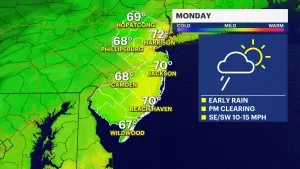More Stories

Erosion is no stranger to the Jersey Shore. Every winter, our local beaches are battered by storms that take away large quantities of sand.
2021 was no exception, with a series of February storms - including a powerful Nor'easter - doing the majority of the damage. This leads to beach restoration projects during the spring months in advance of the hundreds of thousands of beachgoers that flock to the Garden State oases annually.
But one New Jersey town is trying things a little differently.
The borough of Avalon in Cape May County has begun a 'back passing' project that will replenish parts of its shoreline.
What makes back passing different from normal beach restoration? Rather than sucking up the sand from the ocean and depositing it back on shore - a costly process - the sand will be moved from one section of beach to another.
Ocean currents naturally take sand from Avalon’s north end beaches and transport them south. This surplus of sand is called a 'borrow area.'
Avalon's DPW is using heavy equipment to move around 55,000 cubic yards of sand back to to the northern beaches.
Mayor Martin Pagliughi says that back passing is both an efficient and cost-effective way to protect the community between the usual hydraulic beach fill projects, and adds that the project should be completed by Memorial Day Weekend - just a few days before the official start of hurricane season.
While beaches will remain open during the project, certain parts of the borrow and fill areas will be closed. Beach walkers will also have to contend with large and/or noisy machinery along parts of the beach during the repairs.
More from News 12
1:47

Rainy Monday in New Jersey; drier, sunnier conditions ahead
2:13

Temperatures warm to 70 today; tracking Thursday storms
0:55

Colder temperatures return, tracking potential for snow Sunday night
1:14

Lingering showers and fog into Friday; tracking possibility of snow Sunday night
2:25

STORM WATCH: Friday storm will bring cruel chill, deep freeze before Christmas
2:25
